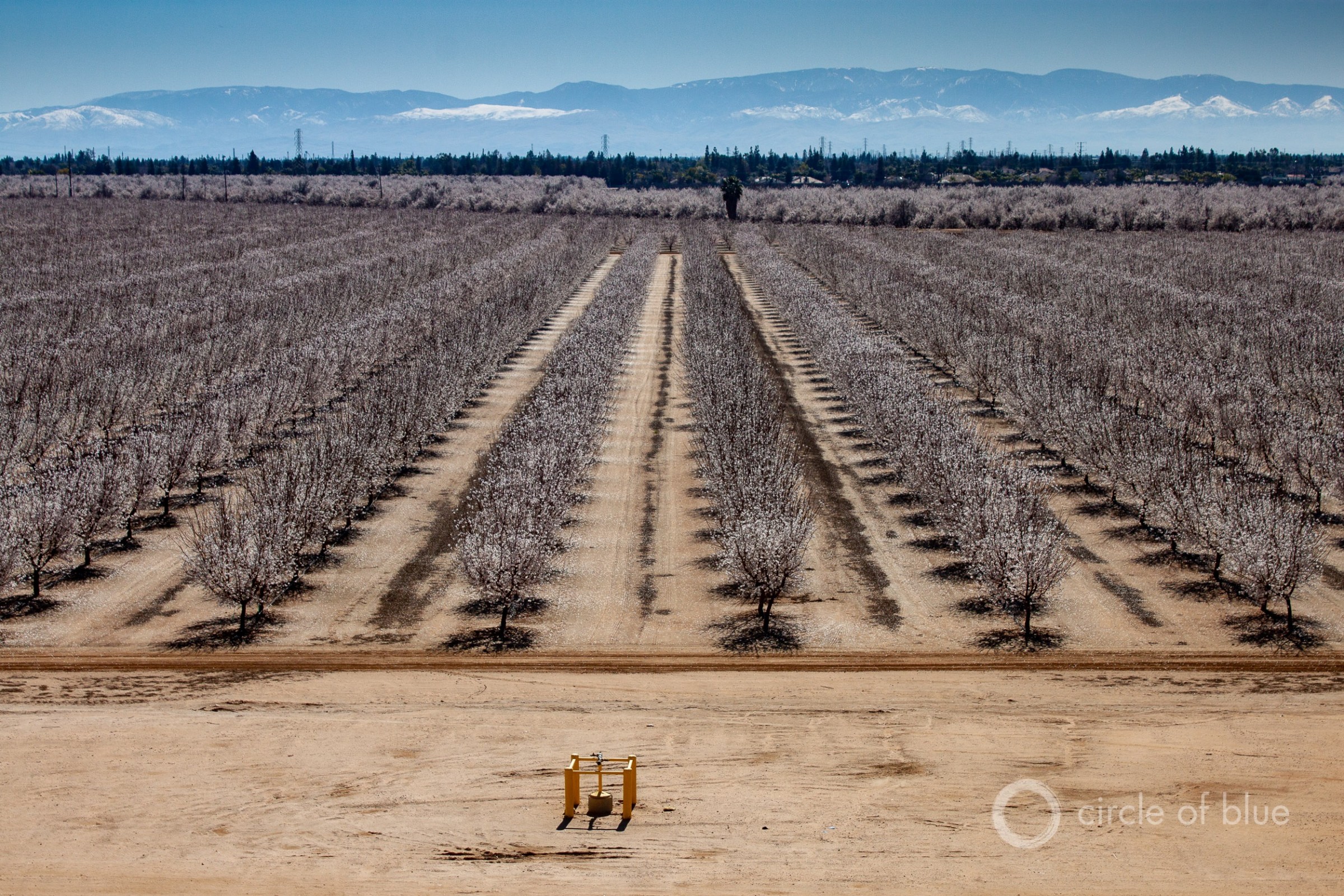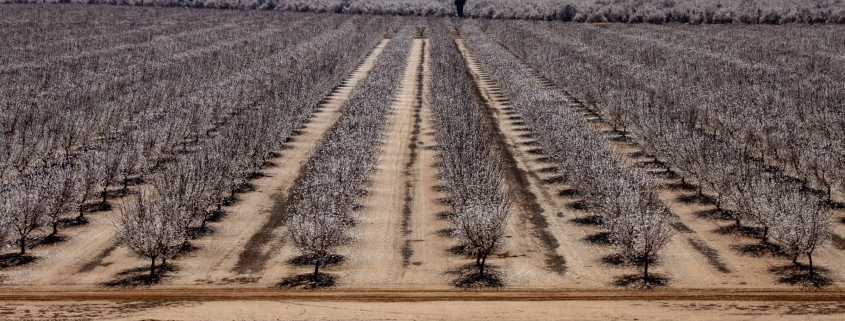U.S. Food Trade Increasingly Leans On Unsustainable Groundwater
Biggest reliance on unsustainable groundwater is in the western states, study finds.

Rows of almond trees extend to the horizon in Kern County, California. Orchards like this one have sprouted in the last decade in areas of California’s Central Valley that are already water stressed. Photo © Brett Walton/Circle of Blue
By Brett Walton, Circle of Blue
American agriculture is a behemoth, a world-leading industry that, while meeting extensive domestic demands, still exports around $140 billion in farm products each year. Soybeans go to China. Cherries to Japan. Baskets of goods to Canada.
Some of that production rests on a risky and unstable foundation, a new study finds. It takes water to grow those crops, and an increasing portion of the country’s irrigation water is unsustainably mined from groundwater sources that are being depleted.
Groundwater use is unsustainable in the long term when the amount of water that is extracted from an aquifer is greater than the amount that enters, via rainfall or artificial means.
A research team led by the University of Illinois at Urbana-Champaign sought to quantify that deficit as it relates to farm irrigation. They wanted to know much of this unsustainable groundwater is used to grow corn, wheat, cotton, and dozens of other crops, said Megan Konar, a lead author for the study. They also wanted to know how much unsustainable groundwater is embedded in the domestic food trade and how much is exported.
Konar and her colleagues combined groundwater depletion data with county-level food trade data. They found that, between 2002 and 2012, unsustainable groundwater use increased by 32 percent in products traded domestically. The increase was 38 percent for exported goods.
If groundwater is like a bank account, then this is deficit spending. Withdrawals can exceed deposits, but there comes a time when the account is drawn too low. For groundwater, there are local consequences for ecosystems, water supply, and farm income. But the risks of not being able to meet future demands because of groundwater depletion also reverberate with the purchasers of those products, Konar explained.
“Agricultural production that depends on unsustainable groundwater use will eventually become infeasible, once groundwater pumping reaches the physical or economic pumping constraints,” the researchers write. “It is therefore essential to understand the risks posed to domestic and international agricultural supply chains by the eventual declines in agricultural production from these locations.”
The study was published online in the journal Water Resources Research.
Scott Jasechko is an assistant professor at the University of California, Santa Barbara, who studies groundwater. He noted that the study opens new windows into water use and the food trade.
“It provides a picture within a given county of something that we hadn’t seen before,” Jasechko told Circle of Blue.
Jasechko, who was not involved in this research, also praised the study for crossing certain academic divides. He said it united hydrological data with trade flow information that is more commonly in the realm of economists.
“They bridged data sets for research communities that rarely talk to each other,” Jasechko said.
There was a reason for that union, Konar said. The wider view reveals how water flows throughout the economy and crosses borders, she explained. The United States dominates the export markets for soybeans and coarse grains, giving the country’s farmers a critical role in global food security.
“It’s important to think about how that water use is integrated into full supply chains,” Konar told Circle of Blue. “It’s not just the agricultural producers who will be directly impacted by unsustainable water use. There are indirect impacts for those who rely on farm products.”
Though the United States is large agricultural exporter, most farm products are sold domestically. Ninety percent of the unsustainable groundwater in 2012 was embedded in products traded within the United States. Collectively, it adds up. Unsustainable groundwater in farm products used domestically was equivalent to the full volume of Lake Mead, the nation’s largest surface reservoir, the study found.
The trade data allowed the research team to see how exposure to water risk is changing downstream of the farm. In 2002, for instance, California’s major trade partners were Europe and the Americas. A decade later, East Asia devoured the lion’s share of California’s exported output. Trade partners are indirectly exposed to risks of groundwater depletion, especially if the deficit spending reaches a break point and production has to be curtailed.
The study’s findings align with other national water trends. While nearly all categories of water withdrawals are decreasing in the United States, groundwater withdrawals for irrigation increased, climbing 16 percent between 2010 and 2015, according to the U.S. Geological Survey.
Groundwater depletion for irrigation increased in the time frame of the study, particularly in major aquifers. California’s Central Valley and the Ogallala aquifer of the High Plains both showed increased depletion.
The researchers also calculated the biggest groundwater depletion footprint, which they defined as depletion per unit of agricultural production. The state with the largest footprint was Arizona, where rural groundwater use is largely unregulated and water tables are dropping. State lawmakers are now calling for legislation that would require stronger monitoring requirements and water-use reports.
The study has some limitations. For one, data sets were mismatched. Water depletion data were from 2000 and 2010, while food production data was from 2002 and 2012. Also, certain crops, like grapes, were not included in the trade data. Konar said they were handcuffed by the data that was available.
If anything, the estimates of unsustainable groundwater use in agriculture are conservative, Konar said. 2012 was a drought year in California and the Midwest. The lack of rain would have increased groundwater use compared with 2010, which was the year of the hydrological data set used in the study.
Jasechko said that these were minor problems in an otherwise powerful study.
“Given the data available, they’ve done an admirable job of merging apples and oranges,” he said. No pun intended.
Brett writes about agriculture, energy, infrastructure, and the politics and economics of water in the United States. He also writes the Federal Water Tap, Circle of Blue’s weekly digest of U.S. government water news. He is the winner of two Society of Environmental Journalists reporting awards, one of the top honors in American environmental journalism: first place for explanatory reporting for a series on septic system pollution in the United States(2016) and third place for beat reporting in a small market (2014). He received the Sierra Club’s Distinguished Service Award in 2018. Brett lives in Seattle, where he hikes the mountains and bakes pies. Contact Brett Walton











Groundwater helps grow our food. 64% of groundwater is used for irrigation to grow crops. Groundwater is an important component in many industrial processes. Groundwater is a source of recharge for lakes, rivers, and wetlands.